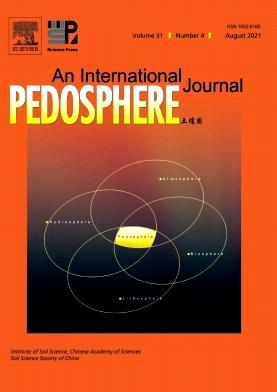Role of nosZ I-carrying microorganisms in regulating nitrous oxide reduction during forest conversion: A comparison of plantations and a secondary forest in subtropical soils
IF 5.2
2区 农林科学
Q1 SOIL SCIENCE
引用次数: 0
Abstract
The conversion of natural forests in subtropical regions to plantations or secondary forests has resulted in alterations in soil variables, microbial communities, and microbially mediated processes, including nitrous oxide (N2O) emissions. However, how forest conversion influences soil N2O reduction and the abundance and community structure of N2O-reducing microorganisms remains unclear. Here, we investigated the impact of converting natural forests to a secondary forest and Cunninghamia lanceolata and Pinus massoniana plantations on the abundance and community structure of N2O-reducing microorganisms in both bulk soils and soil aggregates. Compared with the secondary forest, plantations had higher soil pH and available phosphorus and moisture contents, lower soil NH4+ content, but similar aggregate sizes. Compared with the secondary forest, the conversion of natural forest to plantations resulted in significantly higher soil N2O reduction rate and increased abundances of nosZ I and nosZ II genes in bulk soils and soil aggregates. The abundance of nosZ I was higher than that of nosZ II in all tested soils and had a stronger association with N2O reduction rate, suggesting the greater role of nosZ I-carrying microorganisms in N2O consumption. Forest conversion had a greater impact on the community composition of nosZ I than nosZ II, mainly by increasing the relative abundances of alpha- and beta-Proteobacteria, while decreasing gamma-Proteobacteria. However, nosZ II-carrying microorganisms were exclusively dominated by Gemmatimonadetes and less affected by forest conversion. Taken together, our findings significantly contribute to our understanding of the eco-physiological characteristics of N2O-reducing microorganisms and highlight the importance of nosZ I-carrying microorganisms in N2O consumption in subtropical forest soils.
森林转化过程中携带nosZ i的微生物在调节氧化亚氮还原中的作用:亚热带土壤人工林与次生林的比较
亚热带地区天然林向人工林或次生林的转变导致土壤变量、微生物群落和微生物介导的过程(包括氧化亚氮(N2O)排放)发生变化。然而,森林转换如何影响土壤N2O还原以及N2O还原微生物的丰度和群落结构尚不清楚。本文研究了天然林向次生林、杉木人工林和马尾松人工林对土壤和土壤团聚体中n2o还原微生物丰度和群落结构的影响。与次生林相比,人工林土壤pH、速效磷和水分含量较高,NH4+含量较低,但团聚体粒径相近。与次生林相比,天然林还林后土壤N2O还原速率显著提高,土壤体和团聚体中nosZ I和nosZ II基因丰度显著增加。nosZ I丰度均高于nosZ II,且与N2O还原速率的相关性更强,说明携带nosZ I的微生物在N2O消耗中的作用更大。森林转换对nosZ I群落组成的影响大于nosZ II,主要是通过增加α -和β -变形菌门的相对丰度,而降低γ -变形菌门的相对丰度。而携带nosZ ii的微生物主要以Gemmatimonadetes类为主,受森林转化的影响较小。综上所述,我们的研究结果有助于我们了解N2O还原微生物的生态生理特征,并强调了携带nosZ i的微生物在亚热带森林土壤N2O消耗中的重要性。
本文章由计算机程序翻译,如有差异,请以英文原文为准。
求助全文
约1分钟内获得全文
求助全文
来源期刊

Pedosphere
环境科学-土壤科学
CiteScore
11.70
自引率
1.80%
发文量
147
审稿时长
5.0 months
期刊介绍:
PEDOSPHERE—a peer-reviewed international journal published bimonthly in English—welcomes submissions from scientists around the world under a broad scope of topics relevant to timely, high quality original research findings, especially up-to-date achievements and advances in the entire field of soil science studies dealing with environmental science, ecology, agriculture, bioscience, geoscience, forestry, etc. It publishes mainly original research articles as well as some reviews, mini reviews, short communications and special issues.
 求助内容:
求助内容: 应助结果提醒方式:
应助结果提醒方式:


